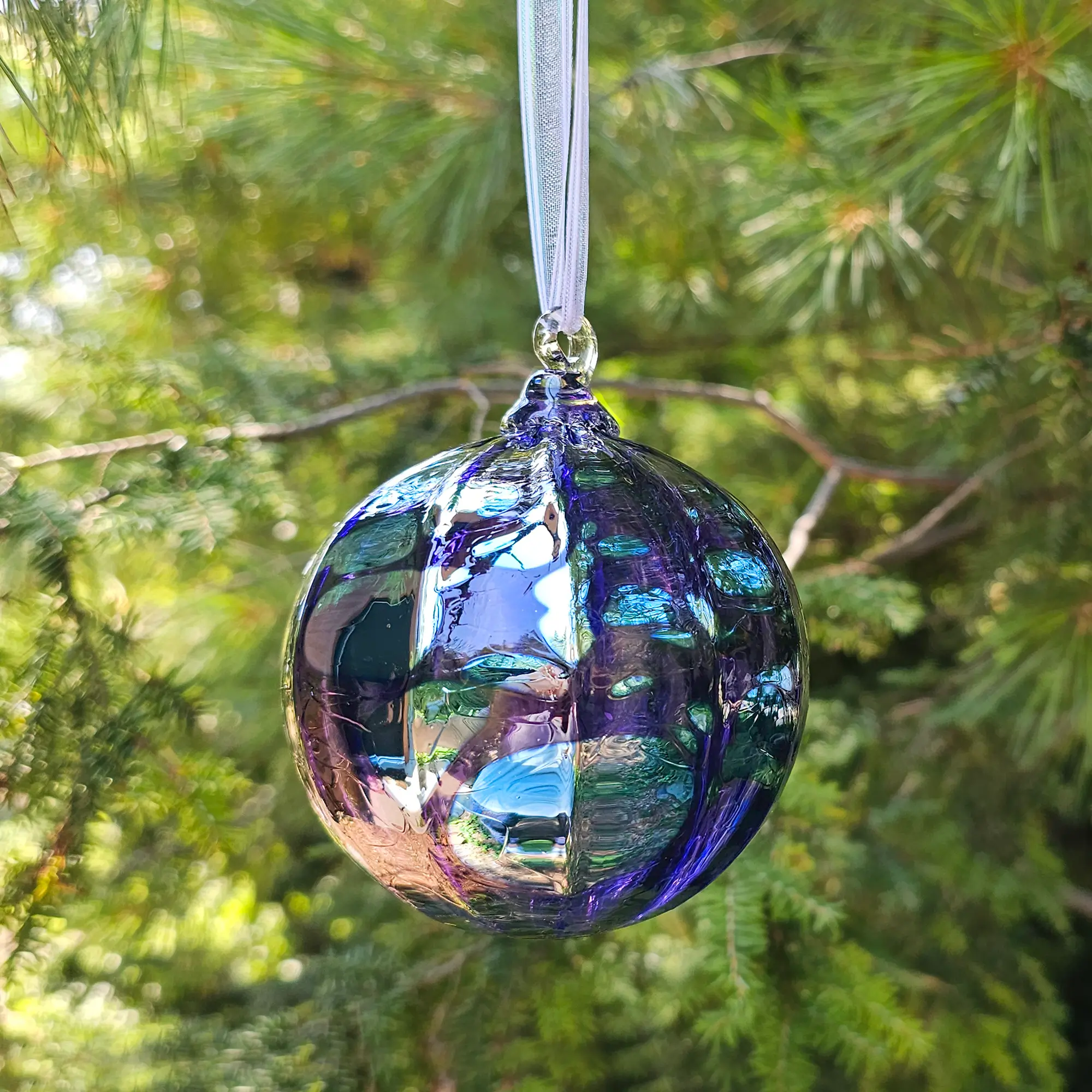
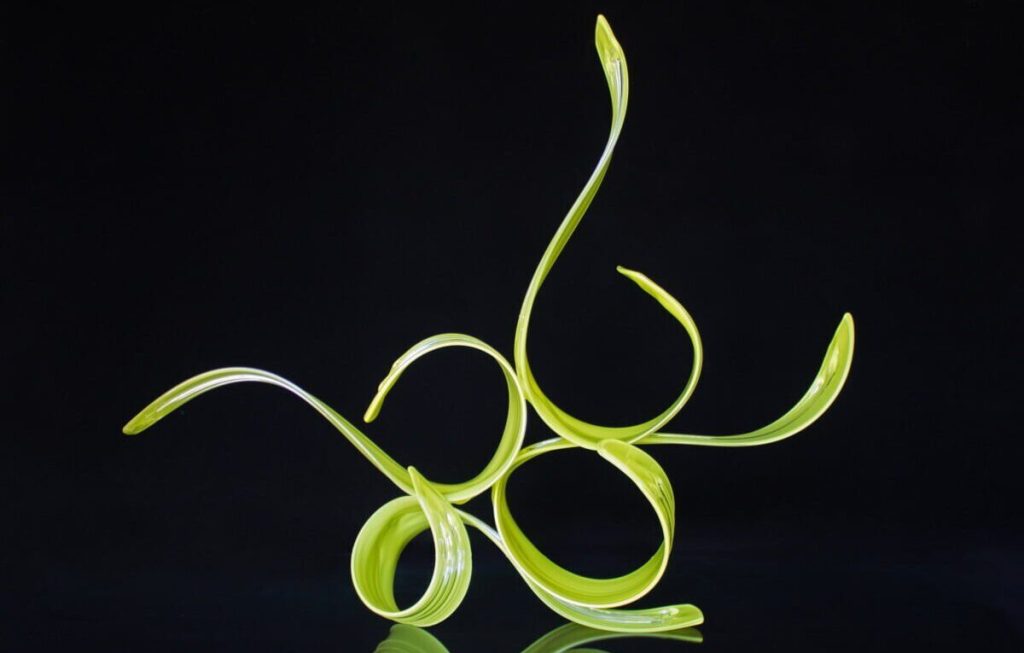
April Wagner has been blowing glass for over twenty years. Throughout this time she has developed her own unique style of glass art. Her work is found in public and private collections around the world. She’s evolved both her skill set and her studio practice. This growth has led to the development of two separate and distinct brands: the epiphany line of functional, semi-functional and decorative objects and the April Wagner line of sculptures. Both are created at epiphany studios, April’s hot-glass facility in Pontiac, MI.

There is definitely precedent for this kind of division under a larger brand umbrella. For example, there are two main fashion brands under the Donna Karan umbrella. Donna Karan New York is a high-end, more customized brand carrying a different line of products for a discerning customer. DKNY, while still premium, offers a more accessible range of products. The epiphany and April Wagner brands function in much the same way. Maintaining separate lines of work gives April room to create a broader range of artwork with different goals and functions. This post will give a more in depth look at what distinguishes epiphany from April Wagner.
April realized it would take years of professional growth and study before she would be able to make what she thought of as beautifully crafted, conceptual artworks. In this time of study, refinement, and exploration she needed a name that would reflect her passion for the material. The word ‘epiphany’ means “insight into the essence of an object and/or material.” In 1993, she chose this name to sign her glass works, marking the beginning of her career.
April knew early on that using her own personal name as a brand would need to wait until her technical and conceptual skills were honed enough to truly demonstrate the evolution. So for 25 years, she has been designing and creating a line of work under the epiphany moniker that deepens her understanding of glass as a functional and decorative material all the while enhancing, growing, stretching, and nurturing her talents as a fine artist and glass sculptor.
The epiphany line consists of pieces that April designed and prototyped with the principle idea of glass as a craft material. They are chiefly decorative objects balancing form, function (in certain instances) and beauty. Production of these pieces is done either by April or the studio artists. Each piece is hand engraved with the name epiphany.
The artwork that falls under the epiphany name includes paperweights, pen holders, ring holders, decanters, pet products, nests and nest vases, Zanfirico bowls, Splash Bowls, pumpkins, rocks glasses, ornaments, and more. The Tornado Decanter (below left) illustrates the perfect balance of form, function, and beauty. The form creates a functional decanting experience, aerating the wine over the inner spiral both entering and exiting the decanter. The functionality in no way compromises the overall design of the decanter, if fact it enhances the inherently beautiful qualities of the glass.

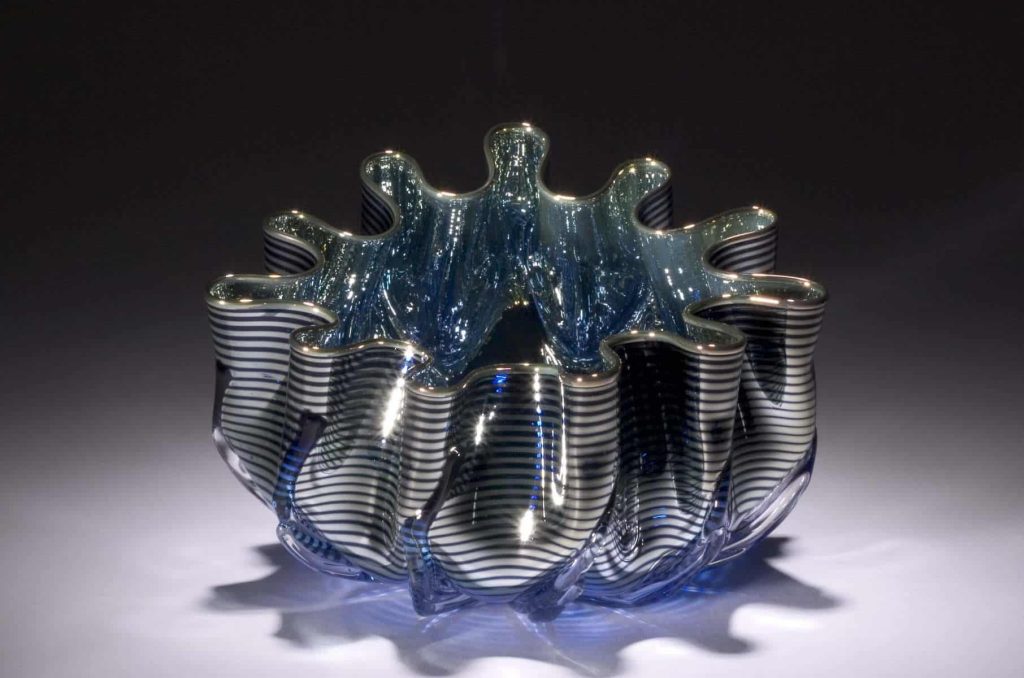
The different lines of epiphany products develop in response to market demand as well as the varying skill levels of the studio assistants. Glassblowing requires a team and has a steep learning curve. It can take well over five years for a novice to become competent, over 20 years to become an expert. We consider each assistant’s skill set. We also aim to develop their skills in a similar fashion to the traditional master/apprentice structure.
This approach to creating art dates back centuries to the old masters like Rembrandt. Apprentices learned the style of the master artist and then produced the artwork. This allowed workshops to take on more commissions and to produce more art while giving apprentices the chance to develop their skills. This practice is still quite common today. Dale Chihuly hasn’t blown glass since the 70s, but rather designs his artwork and delegates the production to studio artists. Though he doesn’t physically interact with glass, Chihuly is still considered a master glass artist.
In our studio practice, April designs all the pieces for the epiphany line. However, this doesn’t mean she has physically made all of them. With our level of production, that just wouldn’t be possible. April does a great deal of glass blowing and works in the studio almost every day. She delegates production of epiphany items to the studio artists. This allows her to focus on her own artwork and larger commissions.
The epiphany line is designed with these objectives in mind:
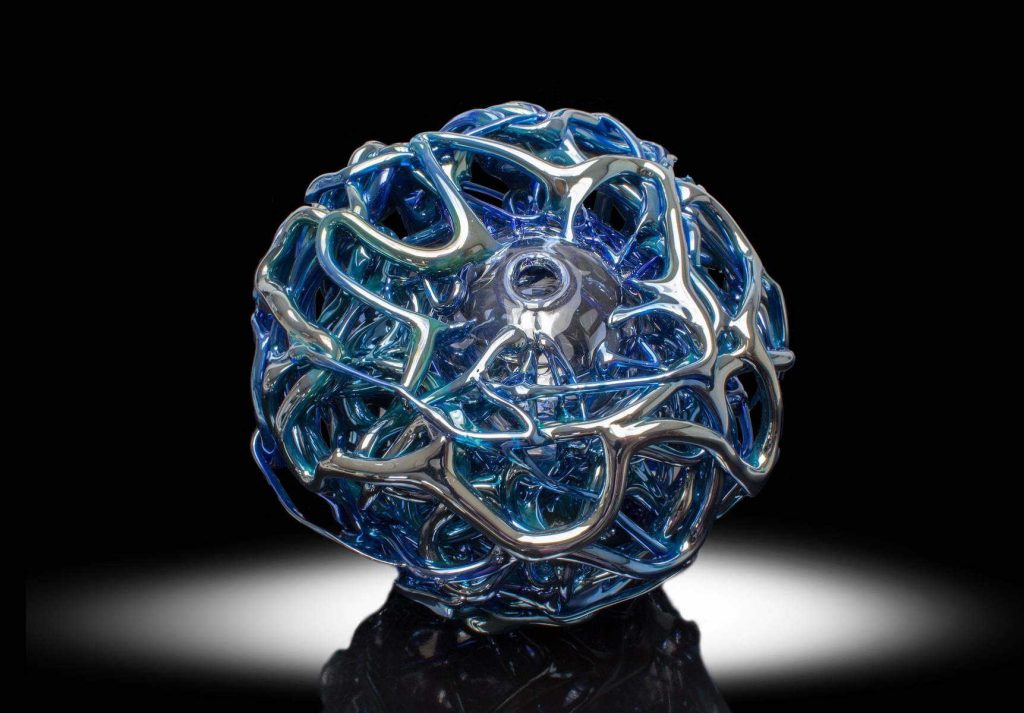

In addition to creating original works, the studio is occasionally approached to make glassworks conceptualized and designed by other individuals or companies. Since glassblowing is such a highly specialized and difficult skill to learn this is not uncommon, but it is not the focus of April’s studio practice. She is very selective when choosing partners for this type of work.
The process of working with outside entities can take a variety of forms depending on the project. The two most common are co-branding and private labeling. Glassblowing is a highly specialized artform. It takes decades to master and uses very specific, expensive and uncommon tools and equipment. Co-branding and private labeling allow designers to hire the studio to create pieces that they wouldn’t otherwise have the skills or resources to produce themselves.
In the past, epiphany engaged in a co-branding experience with the famous interior/product designers Britto Charette. Read their blog post here and here that talks about our award winning project together in 2016.
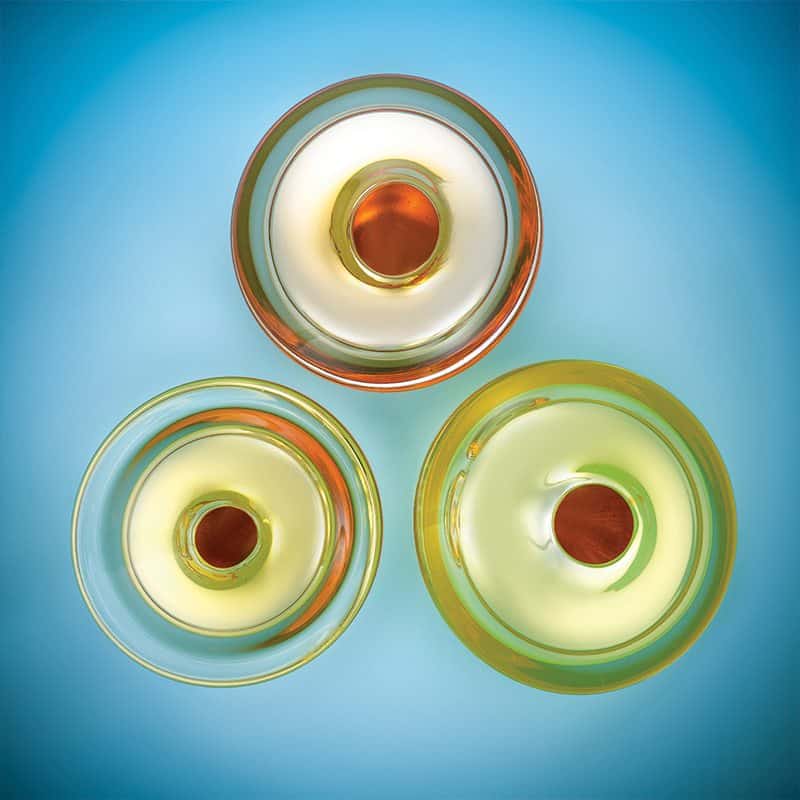

Private labeling is different in that we can’t discuss the products or clients; we sign contracts of non-disclosure. Historically epiphany has created private label products for international luxury retailers who want to have a high-end glass product among their offerings. So while the studio creates the work, the client supplies the design and signed with the client’s name. epiphany is in no way connected or recognized publicly.
April began creating a line of sculptural works in 2000 that she signed with her own name. She started with freestanding pieces, eventually adding wall and hanging sculptures. April creates her unique sculptures for a variety of environments; public, corporate, private and residential. These pieces vary from small studies, or “sketches” as she would call them, to monumental and complex installations. The small sculptures are part of her investigative journey. They question how simple organic shapes and color function in a three-dimensional space. Her large scale sculptures are site-specific installations.
April’s sculptures don’t have utilitarian uses like many of the pieces in the epiphany line. They create a purely visual dialogue with the viewer. The aesthetic of April’s style is based on line quality, visual weight, color, scale and form. She tries to capture the essence of glass as a liquid frozen in time, yet still full of motion and life. This work embraces and glorifies the sensual, captivating, and beautiful nature inherent to glass as a medium.
Often pushing the boundaries of what seems possible and forcing the viewer to respond, April finds the beauty of glass in its inherent contradictions. She explores these opposing forces – glass can be clear or have color. It’s both fragile and strong. Glass is visually soft but also very physically sharp and dangerous. The depth and breadth of April’s vision as a contemporary glass artist is illustrated by her ability to manipulate these characteristics in ways that create beautiful and unique pieces of art.
April’s sculptures are comprised of individually blown glass pieces. They are carefully assembled to explore the limits of line, form, gravity and stability.
Nature inspires a great deal of April’s work. She will often find abstract ways to represent shapes and forms found in nature. Occasionally she will take a more representational approach as seen in the freestanding sculpture, Rabbit Lives at Claire’s House (above right). You can see the variety of techniques she uses to manipulate the glass. She plays with line and color to represent different types of flowers, vines, butterflies and even mushrooms.
Pieces like this also have a whimsical or playful quality. Inspiration comes from literature and various forms of storytelling, such as Alice in Wonderland, Little Shop of Horrors or Dr. Seuss.
April’s large scale installation pieces are site-specific and tailored to match the needs of the client and the end viewer. The needs of a residential space are quite different from the needs of a hotel. While each artwork stylistically is indicative of April’s organic aesthetic, each is unique to the space for which it was conceived.
These large scale projects require April to work closely with clients to understand their needs. She’s often tasked with incorporating essential details, messages or brand vision into her designs, but at the same time, must never compromise the integrity of the art. Therefore, these pieces demand creative design solutions within the constraints of the client’s needs and physical space limitations. Not an easy challenge and one most artists would avoid at all costs. Instead April loves this collaborative challenge, often finding the final artwork to be better conceived and enjoyed.
While April conceptualizes and creates the majority of all of the glass pieces used in her sculptural works, she has to rely on outside vendors for metal fabrication, engineering and electrical expertise. These vendors become partners in the creative process, often anticipating problems, discussing solutions and engineering the complex details of transportation and installation. This article from the NY Times discusses the intimate relationship between artists and their fabricators, acknowledging some of our most visionary works of art could not be created without these highly skilled tradespeople.
We hope you found this post interesting and learned more about our brand! You can find pieces from both lines in our webstore. Stay up-to-date with us on Facebook, Instagram or by signing up for our weekly newsletter. Have a safe and Happy Fourth of July weekend!
The aim of all of April’s work, whether it is the epiphany line or April Wagner sculptures, is to illustrate glass as an ‘epiphany’ while it transmutes from a liquid material to a flowing solid during the process of creation. The movement of the molten glass is captured and frozen in time in various shapes and colors and contextualized for the viewer by the space it is displayed in. April says, “What I love about glass is that it is very immediate and responsive. It is a clear, scintillating, liquid. Then it’s solid and has all these interesting qualities to it that you can bring an idea to or a vision to and really explore. And the glass, in my opinion, responds back. It’s that dialogue that’s really interesting to me.”

Open Shopping: Thursday & Saturday 10 am to 3 pm | Curbside: Tuesday to Saturday: 10 am to 3 pm | Other times: By appointment.
Copyright © 2024 Epiphany Studios. Website by Dorsay Creative